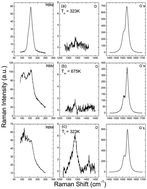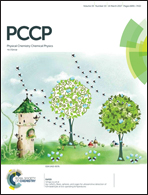Raman spectra of single walled carbon nanotubes at high temperatures: pretreating samples in a nitrogen atmosphere improves their thermal stability in air
Abstract
We present a combined experimental and theoretical study dedicated to analyzing the structural stability and chemical reactivity of single walled carbon nanotubes (SWCNTs) in the presence of air and nitrogen atmospheres in the temperature interval of 300–1000 K. The temperature dependence of the radial breathing mode (RBM) region of the Raman spectra is irreversible in the presence of air, but it is reversible up to 1000 K in a nitrogen atmosphere. Our density functional theory (DFT) calculations reveal that irreversibility is due to partial degradation of SWCNTs produced by dissociative chemical adsorption of molecular oxygen on intrinsic defects of the nanotube surface. Oxygen partially opens the nanotubes forming semi-tubes with a non-uniform diameter distribution observed by Raman scattering. In contrast, heating CNTs in a nitrogen atmosphere seems to lead to the formation of nitrogen-doped SWCNTs. Our DFT calculations indicate that in general the most common types of nitrogen doping (e.g., pyridinic, pyrrolic, and substitutional) modify the location of the RBM frequency, leading also to frequency shifts and intensity changes of the surrounding modes. However, by performing a systematic comparison between calculated and measured spectra we have been able to infer the possible adsorbed configurations adopted by N species on the nanotube surface. Interestingly, by allowing previously nitrogen-exposed SWCNTs to interact with air at different temperatures (up to 1000 K) we note that the RBM region remains nearly unperturbed, defining thus our nitrogen-pretreated SWCNTs as more appropriate carbon nanostructures for high temperature applications in realistic environments. We believe that we have implemented a post-growth heat-treatment process that improves the stability of carbon nanotubes preserving their diameter and inducing a defect-healing process of the carbon wall.



 Please wait while we load your content...
Please wait while we load your content...